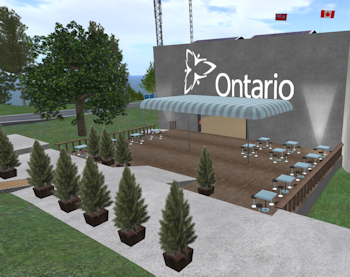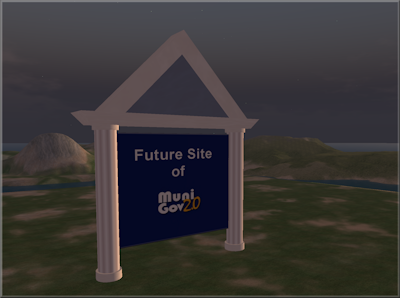 In the first post of this series, I explained my decision about moving my efforts related to building government/public works/engineering sites in virtual worlds from Second Life to OpenSim. And I invited anyone interested to read along or visit as I make this move. From here on out, I will continue to write about the thoughts and processes an agency follows to create and operate a virtual site:
In the first post of this series, I explained my decision about moving my efforts related to building government/public works/engineering sites in virtual worlds from Second Life to OpenSim. And I invited anyone interested to read along or visit as I make this move. From here on out, I will continue to write about the thoughts and processes an agency follows to create and operate a virtual site:
Just like any good story, this one starts at the beginning—back before an agency even sets a digital foot into the virtual arena. Today many agencies might not have even heard of virtual worlds while a few others have heard of them but not yet thought about leveraging this tool to deliver value to citizens. But, eventually someone, either staff or citizens, will bring up the possibility of using virtual worlds to enhance service delivery. At that point the agency must decide whether to ignore the suggestion or investigate virtual solutions. If the agency decides to go forward, the first step is to create a virtual plan. Here are some ideas about how an agency would go about developing their plan:
Developing a Virtual Plan
Create a Project Team
Assuming an agency decides to venture forth, my first suggestion is to form a project team. Team members should be comfortable using online technology, possess good assessment skills and articulation, and have a comprehensive understanding of the agency’s general structure, goals, mission, and strategy. It would also be helpful to include a few community stakeholders on the team such as members of the agency's leadership, residents, business owners, and leaders in community organizations.
Set Goals and Strategies
The team’s first order of business is to determine what the agency would want to accomplish with the use of virtual worlds. These goals should align with the overall goals and strategies for the organization. This is also a good time to think about the targeted audience—who will visit this virtual space? Below are some suggestions for both virtual spaces and related audiences:
- Engage local citizens.
- Attract potential tourists and deliver visitor information.
- Recruit potential employees, citizens, businesses.
- Plan proposed development and receive input from citizens and developers.
- Present 3D representations of code and ordinance requirements so residents/business owners can more easily understand and access regulations.
- Train employees.
Decide on Software and Hosting
In order to develop, access, and maintain these virtual spaces, the agency will need to acquire a software package and possibly a hosting plan. Although virtual worlds may seem like a brand new tool, they function in a manner similar to a traditional Website. By this I mean that the agency will use development software to create the world and the content within. Then others will use a software program to access the agency’s site. And just like a Website, the digital space will require a computer on which to reside. Therefore, the agency will need to determine if their virtual space will be served out from their own computers or through a host.
Here is a list of the more common solutions currently in use for enterprise and government purposes:
Virtual world development can be complex so it’s critical the team identify features and requirements for each software package from cost to performance to ease of use and support. This is where tables and charts come in handy. Here are some suggestions to consider including in the analysis:
Developer Purchase and Annual Cost User base Technical Requirements Security Scalability Backup Capabilities
Database Requirements and Compatibility Storage Requirements
The team can assess each program by assigning a ranking for each feature and requirement. For example, if a low number is chosen to indicate a more beneficial choice, then the purchase price could be categorized by the following numbering system:
1 – $0 to $999
2 – $1,000 to $4,999
3 – $5,000 to $9,999
4 – $10,000 and greater
Technical requirements could be simplified into the following categories for ranking:
1 – Basic computer system costing less than $1,000
2 – Average computer system costing between $1,000 and $2,000
3 – Moderate computer system costing between $2,000 and $3,000
4 – Loaded computer system costing more than $3,000
Categories and rankings should be chosen to best describe each agency’s assessment of needs and capabilities. After assigning a rank to each category and adding up all the points for each feature and requirement, the team can rank the software packages.
Visit Virtual Worlds
Next the team should download the virtual tools and spend time in virtual worlds created by each software solution under consideration. It’s helpful to document observations and first impressions because this can offer insight into how the agency’s user base will experience their first visit. Team members might also visit existing government sites in virtual worlds. Usually people managing these sites are more than willing to share their experiences with others.
Establish a Virtual Site Policy
Visiting virtual spaces can also help the team formulate a virtual space policy for staff and visitors. For employees this policy can address their appearance, communication procedures and guidance, hours of work, and other issues related to representing the agency in a virtual space. For visitors the policy will cover how they should conduct themselves, what they will be allowed to do in the space, how they can dress, if they can access all or just a portion of the space, and consequences for not following the rules.
Develop Virtual Site Designs
After spending time in each world and interviewing managers of existing sites, the team can begin formulating a more specific idea of what they will want to create for their own agency. A framework for each can be designed to meet the agency’s goals and to fit within the constraints and structure of each software package under consideration.
Based on the type of build desired and the goals the agency wants to achieve, the team will develop alternative designs for the site. At this point, designs do not have to be detailed. Simply showing a square labeled “Central Business District” can indicate a design that includes a 3D representation of the agency’s downtown. The most important step is to make sure the designs include elements that allow the agency to achieve their stated goals.

Choose the Development Team
The team must next consider whether the agency can build the virtual site with in-house staff or if a consultant must be hired to perform the work. If the work can be down by agency employees, the team should identify members of a potential development group and their corresponding skills. In making this decision, the team needs to keep in mind not only staff abilities, but the availability of content for each virtual solution. Some worlds, like Second Life, offer extensive ready-made content and building tools that allow most people the ability to create an acceptable space. However, other software solutions require more extensive software skills and offer little to no content.
If a consultant will be hired, the team might want to research potential companies experienced in the creation of virtual worlds. It is important to identify which software tool each company has experience with and visit sites they have created. Interviewing past clients can offer insight into whether the company has the desired experience and understanding to handle a government agency’s requests and needs. Also check to see if the company has retained the employees who created past builds or if you will be working with a new and less experienced staff. Another important consideration is to check with past clients to make sure the company met deadlines and came within budget.
Establish Operations and Management Procedure
Once the site is established, there will be management needs. So the plan should include a section addressing how the site will be staffed and managed during the first few months and then for the long term. Decisions to be made in this step could include if the agency is going to staff the site with existing full or part-time employees or if new employees will be hired. Virtual sites are open 24/7 so the agency also needs to decide on what hours staff will be available at the site. If the agency intends to host events, the hours and staffing for these along with a proposed list of events should be included.
Agencies also prefer to assess operations on a regular basis. If the site is created, this assessment needs to become part of the overall operation and management plan of the agency. With this process in place, the project team can be utilized on a regular basis to review the site on an annually and submit a report indicating how well the site is meeting the goals and objectives laid out in the plan. This procedure can also allow for amendments and changes to be made through an established process.
Compile the Plan
At this point, the team can begin compiling the virtual plan. The plan should include the following elements:
- General proposal and description of what a virtual site is intended to accomplish
- Specific goals, objectives, and strategies and how they fit into the overall agency plan including references to targeted audience/user base
- Listing and discussion of available software solutions with a summary of the team’s findings (a more detailed report can be included in an appendix)
- Proposed virtual site policy
- Concept designs
- Suggested development team
- Timetable for execution of the virtual plan
- Marketing and/or advertising plan including intended channels to be used
- Short term and long term management of the site including staffing proposal
- Assessment procedure
- Budget for software purchase, development, and management
Once a draft of the plan is complete, it is advisable for the agency to host a few public meetings to get input from residents, businesses, and other community stakeholders. Comments should be discussed, and if appropriate, incorporated into the plan. Minutes and comments from all public hearings should be added to the plan as an appendix. The agency's attorney also needs to review the plan at this point and offer any needed revisions.
When the report has been finalized, the team can present the plan to the agency's board or council for formal approval.
Related reading and resources:
"Virtual Spaces: Enabling Immersive Collaborative Enterprise, Part 1: Introduction to the opportunities and technologies" IBM article





